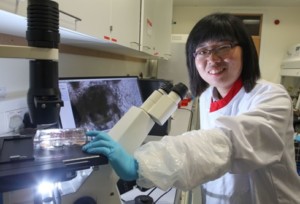Stem Cell Research at NUI Galway may lead to understanding and treatment of heart disease and sudden death in young children.
Biomedical Researchers have developed the first in Ireland synchronised beating heart cells from human pluripotent stem (iPS) cells made from skin biopsy.
The research aims to investigate the causes of unexpected sudden death from inherited cardiac conditions in young people, and to help test therapies that may reduce the risk of sudden death in survivors and relatives. The work is funded in partnership by REMEDI and the National Children’s Research Centre (NCRC).
The discovery of the genetic basis of inherited cardiac conditions, specifically the inherited rhythm disease known as Long QT Syndrome, has advanced our understanding of disease mechanisms and provided an insight into how we ultimately might ‘repair’ the genetic defect. The stem cell scientists at REMEDI in NUI Galway are now in a position to generate patient-specific heart tissue in a dish to test new therapies and treatments.
To continue the next phase of this study NUI Galway is now seeking families affected by Long QT Syndrome to come forward for a skin biopsy on consultation with their doctor. The aim is to recruit both affected and unaffected family members to better understand what places one family member at risk and not another, preferably with the identified causative gene mutation in the family.
Stem cell-derived heart cells have revolutionised our understanding of heart mechanical and electrical communication, coordination and function. Mature human heart cells cannot be grown outside the body under normal conditions, and do not lend themselves easily to scientific interrogation without placing the patient at potential risk. By utilising a skin biopsy sample from a particular patient, the scientists can engineer those same skin cells into heart cells through what is termed ‘re-programming’ and can then create an exact replica of that patients’ heart tissue in a laboratory dish.
This allows researchers to understand in detail the particular patient’s disease and to test or develop therapies without placing the individual patient at any medical risk. New medicines can be tested on these cells for their effectiveness in preventing arrhythmias. Similarly, the genetic defect in the heart cell can be repaired through genome editing and this repaired heart cell can be then directly compared to the diseased heart cell in the lab.

Professor Timothy O’Brien, Director of REMEDI and Co-Principal Investigator at CÚRAM in NUI Galway.
The stem cell study was initiated by Professor Timothy O’Brien, Director of REMEDI and Co-Principal Investigator at CÚRAM in NUI Galway and Dr Terence Prendiville, NCRC Principal Investigator and the Department of Paediatric Cardiology in OLCHC. The research was carried out by Professor Sanbing Shen, Professor of Fundamental Stem Cell Biology and Post-doctoral researcher Dr Min Liu in the Biomedical Sciences Building at NUI Galway.
The researchers in NUI Galway have developed a highly skilled and technically specialised expertise in ‘re-programming’ skin cells into stem cells, and then, in turn, making heart cells out of those same patient’s stem cells. The beating heart tissue can be electrically and mechanically measured and recorded. The ultimate goal is to repair the genetic defect in the affected heart cells using new CRIPSR/Cas9 technology and return the heart cells to normal function.

Dr Min Liu, Post-doctoral researcher in Stem Cell Biology, Biomedical Sciences Building at NUI Galway.
In collaboration with adult and paediatric cardiologists, the scientists at REMEDI will help define the burden of Long QT syndrome in the affected families and develop technologies to measure the effectiveness of therapies and genetic repairs in the dish prior to any human trial.
Affected families with Long QT syndrome will be identified through the National Inherited Cardiac Conditions service delivered across the three campuses of Our Lady’s Children’s Hospital Crumlin, Cardiovascular Risk in the Young at the Adelaide and Meath Hospital, and the Family Heart Screening Clinic at the Mater Misericordiae University Hospital in Dublin. The families that are being selected at this early stage of research are patients with clearly abnormal electrocardiograms which are associated with a risk of sudden death, and a known causative gene mutation.
Skin biopsy samples will be taken using punch biopsies at the research facility at NUI Galway with local anaesthetic, then subsequently grown in a dish and stored locally for further research. Skin cells are relatively simple to grow in a lab and lend themselves well to being ‘re-programmed’ to pluripotent stem cells by Nobel prize-winning technology applied at REMEDI.
Once a patient-derived stem cell population has been generated in the lab, the next step is to produce beating heart cells using timed application of selective growth factors in a particular sequence using established research protocols. Beating heart cells in the dish can then be electrically measured using tiny electrodes akin to an electrocardiogram in a human patient. Skin samples are also being obtained from closely related but unaffected family members to allow a comparison between normal and diseased heart cells.
Once the pipeline for generating patient-derived heart tissue has been robustly tested for Long QT syndrome, the same scientific technology will be used to explore other inherited arrhythmia conditions and cardiomyopathies.
Professor Timothy O’Brien from NUI Galway, said:
“We are excited about the potential to develop new therapies for children at risk of sudden death using this technology. The complete translational infrastructure for this work is now present in Galway and will be extended nationally with our collaborators in Dublin and throughout Ireland.”
Dr Terry Prendiville from Our Lady’s Children’s Hospital Crumlin said:
“I meet families every week in the hospital from all over Ireland who have been affected by the sudden unexpected death of a loved one. Their first question to me is: “Could this affect my child?” Their next question is: “How do I keep them safe?”
“Research such as this allows us to continue to push the envelope on developing medical therapies that safeguard against risk of sudden death.”
Dr Jacinta Kelly, CEO of the NCRC said:
“I would like to welcome this research which has arisen from an exciting partnership between the NCRC and REMEDI. We, at the NCRC, are looking forward to continuing to work with our colleagues at REMEDI to find therapies to address the issue of congenital heart defects in children.”
If you would like to participate in this study and you have a diagnosis of Long QT syndrome with a known gene mutation, please contact Dr Terence Prendiville at Our Lady’s Children’s Hospital Crumlin for further information and eligibility criteria.
Email: Terence.prendiville@olchc.ie